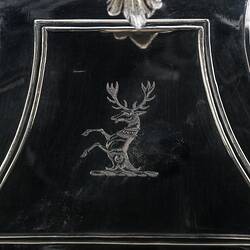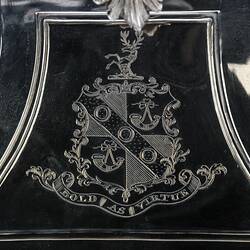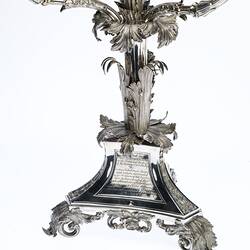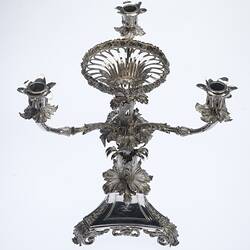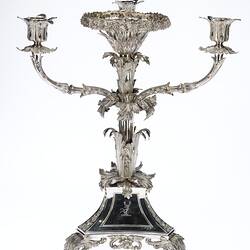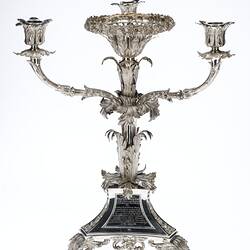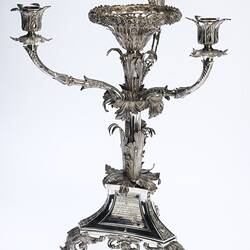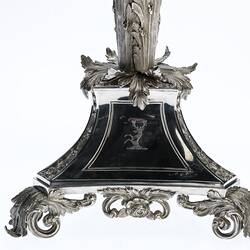Summary
Candelabra Epergne centrepiece which is part of a testimonial gifted to Captain William Lonsdale, upon retiring from his position as Chief Magistrate and Commandant of Port Phillip. Nearly 90 subscribers contributed between one and five guineas each to raise a total of £350. The testimonial was presented to Lonsdale at the Melbourne Club on Tuesday 28th January 1840. The ensuing service, comprising a centrepiece, soup tureen, entree dishes, a salver, salt cellars, a tea coffee service and cutlery, was acquired for him in England and arrived in Melbourne in 1842. It was a composite service by different makers with components in varying styles made at different dates, from circa 1828 to 1841. Clearly the Mr W.H. Yaldwyn, who purchased the silver in London for Lonsdale, bought readymade examples rather than commissioning a service from one maker.
William Lonsdale became a lieutenant in the 4th Regiment of the British Army in 1824 and arrived in Sydney in December 1831. During the next five years he served in Van Diemen's Land and in New South Wales. In September 1936 Lonsdale was chosen by Governor Sir Richard Bourke to be the first police magistrate at Port Phillip. Lonsdale, his wife, children and two servants sailed in H.M.S. Rattlesnake, which anchored near the mouth of the Yarra River on 29 September 1836. Lonsdale was instructed to perform not only the ordinary jurisdiction of a justice of the peace, but also 'the general superintendence in the new settlement of all such matters as require the immediate exercise of the authority of the government' in accordance with the applicable laws of England and the acts of the governor and council. He was to send in returns and reports, take a census particularly noting land occupation, protect and conciliate the First Peoples population and try to induce them to offer their labour in return for food and clothing, employing as the medium of communication with them 'the European named Buckley'.
Charles La Trobe, who arrived in Melbourne in October 1839 as the first superintendent of Port Phillip, relieved Lonsdale of all the disputed areas of responsibility. Lonsdale continued to act as police magistrate until April 1840, when he was appointed sub-treasurer of Port Phillip. In 1851, when Victoria became a separate colony, Lonsdale was nominated by La Trobe as its first colonial secretary. He became colonial treasurer in 1853, then returned to the UK in 1854 and died in London on 28th March 1864. Lonsdale Street, Melbourne, and Point Lonsdale were named after him, and Mount Martha after his wife.
Physical Description
Candelabra Epergne with body in three sections chased with overlapping acanthus leaves, rising to three leaf capped scroll arms terminating in sconces, centered by an openwork basket with a leaf tip skirt and a leaf and berry cast border to the upper edge. The body sits on a tri-form base. The base is inscribed, the two remaining cartouches bearing the Lonsdale family coat of arms with the motto 'BOLD AS VIRTUE' and the Lonsdale family Stag crest respectively, within acanthus leaf and corn husk borders. It sits on raised on leaf cast feet united by a pierced apron, date mark rubbed but William IV monarch duty mark legible and dateable to 1830-37. Approximately 3,170 grams total weight of silver.
Significance
The Lonsdale service is a rare surviving example of large dinner service that has remained intact since it was acquired by William Lonsdale in 1842. In nineteenth-century Australia it was common practice to present notable figures with luxurious presentation objects made of silver. These usually took the form of a testimonial presentation with funds raised from subscribers. Sometimes the recipient was given cash to purchase something for himself: more frequently a grand silver centrepiece or suite of silver was presented directly.
This centrepiece directly references Lonsdale's role in the establishment of the colony of Port Philip between 1836 and 1839. In representing the foundations of colonial Melbourne it also marks the dispossession of the Kulin people from their lands and the formalisation of the invasion of white settlers.
More Information
-
Collecting Areas
-
Acquisition Information
Purchase from Sotheby's Australia, Guy Cairnduff - Sotheby's Australia
-
Acknowledgement
This item was purchased with the support of the Australian Government through the National Cultural Heritage Account.
-
Presented To
William Lonsdale, 36 Collins Street, Melbourne, Victoria, Australia, 28 Jan 1840
-
Maker
Robinson, Edkins & Aston, Birmingham, England, Great Britain, circa 1830-1837
-
Inscriptions
The Centrepiece bears an extensive inscription: 'Presented to / WILLM. LONSDALE ESQR. / of the Town and District / of Melbourne Port Phillip / By / certain inhabitants thereof / and others interested / in the Welfare of the District / As a testimonial of their / high estimation of his valuable / services as a Public Officer / and of his exemplary character / in the varied relations of private life. / A.D. 1839'.
-
Classification
-
Category
-
Discipline
-
Type of item
-
Overall Dimensions
475 mm (Height), 3.1 kg (Weight)
-
Keywords

